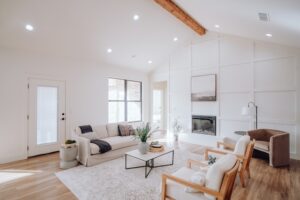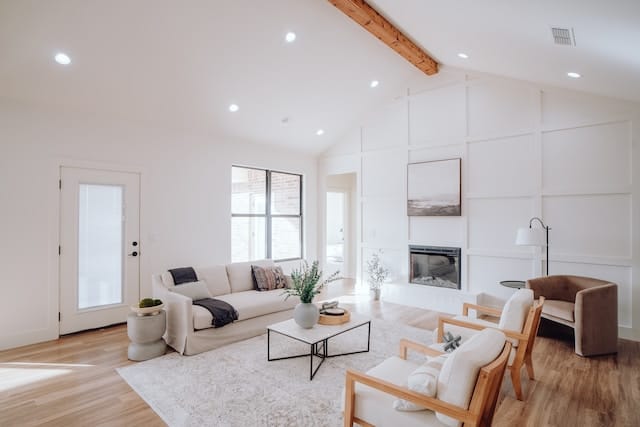Open floor plans are more common today than ever before. Many homeowners are looking for the opportunity to make their homes feel more like cohesive spaces. With an open kitchen, dining area, and living room, you can create a welcoming space that feels inclusive. Paint colors can help you achieve this goal. At Steiner Homes, we know the importance of making decisions for your home that help to make it more comfortable, and we understand that painting your home is a crucial part of that. These tips will help you choose a paint color for your open floor plan.
Start by Painting the Innermost Rooms

Image by Bailey Alexander is licensed with Unsplash License
Often, painting the central rooms first is ideal. You can start with the center of your home and work toward the outer rooms. If you don’t have a central room to focus on, it’s a good idea to start with the room in your home that you’d like to serve as its hub. Choose the color that best represents the tone you’d like to set in your home. Then, you can branch out from here and tie other rooms together with colors that make your home feel cohesive.
If you’re still struggling to find a color for that central room, think about choosing one focal point within it. You may have a piece of furniture you want to emphasize, or maybe you want to match the walls with your kitchen cabinets. Choose a similar or complementary color to bring out desirable elements within the space. This’ll help create a nice flow for each room, even if you don’t use the same color throughout your home.
Another benefit of starting with an innermost room is that you can use it to create a bold statement. For instance, you might paint the walls chocolate brown or add a maroon accent wall. The other rooms will help even out the dramatic color.
Use Monochromatic Palettes
Many people fear using a monochromatic color palette because they think it’ll create an uninspiring look. This couldn’t be further from the truth. In fact, you can do a lot with different shades in your home. Choose a color family, such as blue or orange, to explore. For example, you might use dark blue in the dining room to create a more formal atmosphere, but then use a lighter blue in a kitchen where you want an airier feel. Using this technique ties the various rooms of your home together seamlessly.
Consider Sticking With Warm or Cool Undertones
The undertone of the paint colors you choose will significantly impact the atmosphere of the room. In fact, the undertone of the paint color is just as important as the actual color. If you choose a warm yellow rather than a cool yellow, that warmth will be evident. In the worst-case scenario, that yellow might appear dingy in the wrong room. In contrast, using a yellow that’s too cool for a room may make that space appear stark and cold.
Maintain One Trim Color
No matter what color you use for your walls, using the same color for all the trim throughout your home is a good idea. White is a safe choice for molding, baseboards, window frames, and other small accents. This helps connect the rooms and prevents a disjointed feel when walking around your home.
Neutral Paint Colors Create a Sense of Openness
Neutral colors are always a safe choice for an open floor plan. White, beige, gray, and tan are all fantastic options for creating a home that feels comfortable and open. The good thing about using neutral colors is that they help to maintain a cohesive look from one room to another.
Warm gray tones are dynamic and complement both cool and other warm tones. Linen is another versatile option that works well because it’s lighter than beige and can pair with grays, whites, browns, and other colors. Eggshell is another great idea if you’d like to use a neutral tone that creates a cozy atmosphere. It absorbs light well, which makes it an excellent choice for rooms with many windows.
Earth Tones Combine With Other Palettes
Earth tones are becoming more popular with open floor plans. That’s because earth tones combine well with other colors, including neutral and jewel-like tones. Earth tones also blend well with each other. For example, an eggplant color paired with an olive shade can create a stylish but dramatic look that you can echo throughout the rest of the home with different tones. For instance, you might use eggplant and olive in the living room, but use a lighter purple color and a warmer green shade in the dining room.
Play With Brown and Blue
Browns and blues are also a wonderful pairing for an open floor plan, particularly if you’d like to make sure that your furniture matches the paint colors. You certainly don’t have to make a big statement with these shades. For example, if you have a lot of dark brown furniture in your dining room, you might pair it with a pale blue and a dark chocolate accent wall. These shades have many different tones and pair with lots of different furniture colors.
Play With Textures
When you choose a color for the walls in your home, you might also consider applying fun textures in some of the rooms. Wallpapers and textured paints can add more depth to some of your rooms and help zone your open floor plan more clearly. Darker, more dramatic textures may work best in rooms with lots of natural lighting.
If you have a home with an open floor plan, you want to make sure that every room looks fabulous. Here at Steiner Homes, we know the impact of a home’s floor plan on your comfort level. Consider your floor plan and overall style when choosing a paint color. Still can’t decide what colors to use? Our experienced team would love to help you out.

